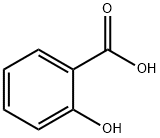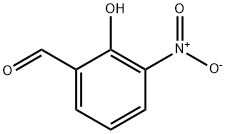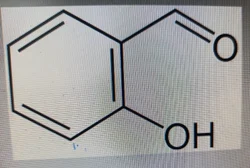Salicylaldehyde
Synonym(s):2-Hydroxybenzaldehyde;Salicylaldehyde
- CAS NO.:90-02-8
- Empirical Formula: C7H6O2
- Molecular Weight: 122.12
- MDL number: MFCD00003317
- EINECS: 201-961-0
- SAFETY DATA SHEET (SDS)
- Update Date: 2025-12-17 09:49:56

What is Salicylaldehyde?
Description
Salicylaldehyde (2-hydroxybenzaldehyde) is an organic compound with the formula C6H4CHO-2-OH. Along with 3-hydroxybenzaldehyde and 4-hydroxybenzaldehyde, it is one of the three isomers of hydroxybenzaldehyde. It is a colorless or pale yellow liquid with a bitter almond odor and a burning taste. It is soluble in alcohol, benzene, and ether, and very slightly soluble in water. Salicylaldehyde is found in shrubs of the genus Spiraea and is usually produced from phenol by the action of chloroform in the presence of an alkali base. It is used in the production of coumarin, saligenin, and salicylaldoxime (an important analytical reagent), and also in analytical chemistry—for example, to detect hydrazine. Besides, salicylaldehyde is a key precursor to various chelating agents and a flavouring ingredient.
Chemical properties
Salicylaldehyde is a colourless to yellow oily liquid with a pungent, irritating, bitter, almond-like odor similar to benzaldehyde, acetophenone and nitrobenzene, but with phenolic notes. It has a nut-like, coumarin flavor at low levels. slightly soluble in water, soluble in ethanol and ether. It turns purple in case of ferric chloride.
Occurrence
Occurs frequently in nature; in the flowers of Spirea ulmaria and other Spireae, in the roots of Crepis foetida L., in the fruits of Pinus avium, in the rind of Rauqolfia caffra, in the leaves of Ceanothus velutinus and in the essential oil of Cinnamomum cassia and of tobacco leaves. Also reported found in grapes, tomato, baked potato, cinnamon bark, cassia leaf, peppermint oil, pennyroyal oil, parmesan cheese, butter, milk powder, roasted chicken, beer, rum, Japanese whiskey, sherry, coffee, tea, soybean, mushroom, buckwheat, Bourbon vanilla, Chinese quince, Muscat grape, vanilla and mastic gum oil.
The Uses of Salicylaldehyde
Salicylaldehyde, is used as flavor and fragrance components. Salicylaldehyde is also a common highly-functionalized arene, that can be used as a precursor in the synthesis of other chemicals.
What are the applications of Application
Salicylaldehyde is a multi-functional arene synthesis reagent
Definition
ChEBI: Salicylaldehyde is a hydroxybenzaldehyde carrying a hydroxy substituent at position 2. It has a role as a nematicide and a plant metabolite.
Preparation
Salicylaldehyde is synthesized from phenol, chloroform, and alkali according to the Reimer–Tiemman method, which was developed in 1876. starting material for the manufacture of coumarin.
Aroma threshold values
Detection: 30 ppb
Taste threshold values
Taste characteristics at 20 ppm: spicy, medicinal and astringent
Synthesis Reference(s)
Synthetic Communications, 24, p. 1757, 1994 DOI: 10.1080/00397919408010181
General Description
Liquid; colorless or pale yellow; bitter almond odor. Sinks and mixes slowly in water.
Reactivity Profile
Salicylaldehyde is an aldehyde. Aldehydes are frequently involved in self-condensation or polymerization reactions. These reactions are exothermic; they are often catalyzed by acid. Aldehydes are readily oxidized to give carboxylic acids. Flammable and/or toxic gases are generated by the combination of aldehydes with azo, diazo compounds, dithiocarbamates, nitrides, and strong reducing agents. Aldehydes can react with air to give first peroxo acids, and ultimately carboxylic acids. These autoxidation reactions are activated by light, catalyzed by salts of transition metals, and are autocatalytic (catalyzed by the products of the reaction). The addition of stabilizers (antioxidants) to shipments of aldehydes retards autoxidation.
Health Hazard
Salicylaldehyde is a skin irritant; 500 mg/daycaused moderate irritation to rabbit skin. Itcan have injurious effects on fertility. Studieson rats indicate that subcutaneous administrationof salicylaldehyde in a high doseof >400 mg/kg can produce developmentalabnormalities, fetal death, and postimplantationmortality.
The toxicity of this compound, however,is low. No toxic symptoms were noted.
LD50 value, oral (rats): 520 mg/kg
LD50 value, skin (rats): 600 mg/kg.
Fire Hazard
Combustible. Can react with oxidizing materials.
Purification Methods
It is precipitated as the bisulfite addition compound by pouring the aldehyde slowly and with stirring into a 25% solution of NaHSO3 in 30% EtOH, then standing for 30minutes. The precipitate, after filtering at the pump, and washing with EtOH, is decomposed with aqueous 10% NaHCO3, and the aldehyde is extracted into diethyl ether, dried with Na2SO4 or MgSO4, and distilled, under reduced pressure. Alternatively, salicylaldehyde is precipitated as its Cu complex by adding it to warm, saturated aqueous Cu(OAc)2, shaking and standing in ice. The precipitate is filtered off, washed with EtOH, then Et2O, and decomposed with 10% H2SO4; the aldehyde is extracted into Et2O, dried and vacuum distilled. It was also purified by dry column chromatography on Kieselgel G [Nishiya et al. J Am Chem Soc 108 3880 1986]. The acetyl derivative has m 38-39o (from pet ether or EtOH) and b 142o/18mm, 253o/atm. [Beilstein 8 IV 176.] The oxime, [94-67-7] M 137.1, crystallises CHCl3/pet ether (b 40-60o) with m 57o [Beilstein 8 IV 203.]
Waste Disposal
Salicylaldehyde is burned in a chemicalincinerator equipped with an afterburner andscrubber.
References
- https://en.wikipedia.org/wiki/Salicylaldehyde
- https://pubchem.ncbi.nlm.nih.gov/compound/salicylaldehyde#section=Top
- http://www.wisegeek.com/what-is-salicylaldehyde.htm
- https://www.merriam-webster.com/medical/salicylaldehyde
- http://encyclopedia2.thefreedictionary.com/Salicylaldehyde
Properties of Salicylaldehyde
| Melting point: | 1-2 °C (lit.) |
| Boiling point: | 197 °C (lit.) |
| Density | 1.146 g/mL at 25 °C (lit.) |
| vapor density | 4.2 (vs air) |
| vapor pressure | 1 mm Hg ( 33 °C) |
| refractive index | n |
| FEMA | 3004 | SALICYLALDEHYDE |
| Flash point: | 170 °F |
| storage temp. | -20°C |
| solubility | 4.9g/l |
| form | Liquid |
| pka | 8.37(at 25℃) |
| color | Clear yellow |
| Odor | Bitter almonds |
| PH | 6-8 (H2O, 20℃)Not applicable |
| Water Solubility | slightly soluble |
| Sensitive | Air & Light Sensitive |
| Merck | 14,8326 |
| JECFA Number | 897 |
| BRN | 471388 |
| Exposure limits | ACGIH: TWA 5 ppm (Skin) OSHA: TWA 5 ppm(19 mg/m3) NIOSH: IDLH 250 ppm; TWA 5 ppm(19 mg/m3); Ceiling 15.6 ppm(60 mg/m3) |
| Dielectric constant | 13.9(20℃) |
| Stability: | Stable. Combustible. Incompatible with strong bases, strong reducing agents, strong acids, strong oxidizing agents. |
| CAS DataBase Reference | 90-02-8(CAS DataBase Reference) |
| NIST Chemistry Reference | Benzaldehyde, 2-hydroxy-(90-02-8) |
| EPA Substance Registry System | Salicylaldehyde (90-02-8) |
Safety information for Salicylaldehyde
| Signal word | Warning |
| Pictogram(s) |
 Exclamation Mark Irritant GHS07  Health Hazard GHS08  Environment GHS09 |
| GHS Hazard Statements |
H302:Acute toxicity,oral H315:Skin corrosion/irritation H319:Serious eye damage/eye irritation H341:Germ cell mutagenicity H411:Hazardous to the aquatic environment, long-term hazard |
| Precautionary Statement Codes |
P202:Do not handle until all safety precautions have been read and understood. P273:Avoid release to the environment. P301+P312:IF SWALLOWED: call a POISON CENTER or doctor/physician IF you feel unwell. P302+P352:IF ON SKIN: wash with plenty of soap and water. P305+P351+P338:IF IN EYES: Rinse cautiously with water for several minutes. Remove contact lenses, if present and easy to do. Continuerinsing. P308+P313:IF exposed or concerned: Get medical advice/attention. |
Computed Descriptors for Salicylaldehyde
| InChIKey | SMQUZDBALVYZAC-UHFFFAOYSA-N |
Salicylaldehyde manufacturer
JSK Chemicals
New Products
4,4-Difluoropiperidine hydrochloride tert-butyl 9-methoxy-3-azaspiro[5.5]undecane-3-carboxylate Indole Methyl Resin N-Isopropylurea N,N-Dicyclohexylcarbodiimide(DCC) MELDRUMS ACID 5-METHYLISOXAZOLE-4-CARBOXYLIC ACID Magnessium Bis glycinate Zinc ascorbate 1-bromo-2-butyne 2-acetamidophenol 9(10H)-anthracenone Erythrosin B, 4-Piperidinopiperidine 2-((4-morpholinophenylamino) (methylthio) methylene) malononitrile 2,4-dihydroxybenzaldehyde 3-(4-morpholinophenylamino)-5-amino-1H-pyrazole-4-carbonitrile Methyl 2-methylquinoline-6-carboxylate 2,6-dichloro-4-nitropyridine 4-Bromo-2-chlorobenzonitrile 2-(benzylamino)acetic acid hydrochloride 4-(tert-Butoxycarbonylamino)but- 2-ynoic acid 3,4-dihydro-2H-benzo[b][1,4]dioxepine 1-Phenyl-1-cycloprppanecarboxylicacidRelated products of tetrahydrofuran








You may like
-
 Salicylaldehyde 99%View Details
Salicylaldehyde 99%View Details -
 SALICYLALDEHYDE 99%View Details
SALICYLALDEHYDE 99%View Details -
 Salicylaldehyde extrapure AR CAS 90-02-8View Details
Salicylaldehyde extrapure AR CAS 90-02-8View Details
90-02-8 -
 Salicylaldehyde pure CAS 90-02-8View Details
Salicylaldehyde pure CAS 90-02-8View Details
90-02-8 -
 Salicylaldehyde 98% (GC) CAS 90-02-8View Details
Salicylaldehyde 98% (GC) CAS 90-02-8View Details
90-02-8 -
 Salicylaldehyde 98% CAS 90-02-8View Details
Salicylaldehyde 98% CAS 90-02-8View Details
90-02-8 -
 Salicylaldehyde Cas No . 90-02-08View Details
Salicylaldehyde Cas No . 90-02-08View Details
90-02-8 -
 Salicylaldehyde,C7H6O2,CAS 90-02-8, For Industrial UseView Details
Salicylaldehyde,C7H6O2,CAS 90-02-8, For Industrial UseView Details
90-02-8
